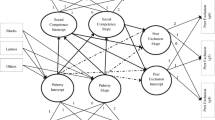Abstract
In male and female adolescents aged 14, 15, 17, and 18 years of age, the predictive relationship between social competency and peer relations and age differences in social competence were studied. Based upon a social deficit hypothesis, linear age differences were observed in social knowledge, locus of control, and a trend in empathy. Some sex differences were found, but no sex by age interactions were observed. The predicted relationship between social competency and peer popularity was supported, but was different according to sex of the adolescent.
Similar content being viewed by others
References
Achenbach, T. M., and Edelbrock, C. S. (1981). Behavioral problems and competencies reported by parents of normal and disturbed children aged four through sixteen.Monogr. Soc. Res. Child Dev. 46: 1–82.
Adams, G. R., Schvaneveldt, J. D., and Jensen, G. O. (1979). Sex, age and perceived competency as correlates of empathic ability in adolescence.Adolescence 14: 811–818.
Adams, G. R., Shea, J., and Kacerguis, M. A. (1978). Development of psychosocial maturity: A review of selected effects of schooling.Urban Educ. 13: 255–282.
Anderson, S., and Messick, S. (1974). Social competency in young children.Dev. Psychol. 10: 282–293.
Baumrind, D. (1982). Are androgynous individuals more effective persons and parents?Child Dev. 53: 44–75.
Bell, G. B., and Hall, H. E. (1954). The relationship between leadership and empathy.J. Abnorm. Soc. Psychol. 49: 156–157.
Coleman, J. S. (1961).The Adolescent Society, Free Press, New York.
Dymond, R. (1950). Personality and empathy.J. Consult. Psychol. 14: 343–350.
Dymond, R., Hughes, A., and Raabe, V. (1952). Measurable changes in empathy with age.J. Consult. Psychol. 16: 202–206.
Ford, M. E. (1981). Androgyny as self-assertion and integration implications for psychological and social competence. Stanford University, School of Education; submitted for publication.
Ford, M. E. (1982). Social cognition and social competence in adolescence.Dev. Psychol. 18: 323–340.
Greenberger, E., and Sorensen, A. B. (1974). Toward a concept of psychosocial maturity.J. Youth Adoles. 3: 329–358.
Janes, C. L., Hesselbrock, V. M., Myers, D. G., and Penniman, J. H. (1979). Problem boys in young adulthood: Teachers' ratings and twelve-year follow-up.J. Youth Adoles. 8: 453–472.
Johnson, D. W., and Johnson, R. T. (1978). Cooperative, competitive and individualistic learning.J. Res. Dev. Educ. 12: 3–15.
Lifshitz, M. (1973). Internal-external locus-of-control dimension as a function of age and the socialization milieu.Child Dev. 44: 538–546.
Nicholson, S. I., and Antill, J. K. (1981). Personal problems of adolescents and their relationship to peer acceptance and sex-role identity.J. Youth Adoles. 10: 309–325.
Nowicki, S. (1975). The effect of locus of control on peer relationships across different age groups.J. Genet. Psychol. 94: 275–280.
Nowicki, S., and Barnes, J. (1973). Effects of a structured camp experience on locus of control orientation.J. Genet. Psychol. 122: 247–252.
Penk, W. E. (1969). Age changes and correlates of internal-external locus of control scale.Psychol. Rep. 25: 856.
Rose, G., Frankel, N., and Kerr, W. (1956). Empathic and sociometric status among teenagers.J. Genet. Psychol. 89: 277–278.
Rothenberg, B. (1970). Children's social sensitivity and the relationship to interpersonal competence, intrapersonal comfort, and intellectual level.Dev. Psychol. 2: 335–350.
Rotter, J. B. (1966). Generalized expectancies for internal versus external control of reinforcement.Psychol. Monogr. 80(Whole No. 609).
Author information
Authors and Affiliations
Additional information
Support for this project was provided by the Science/Education Administration of the USDA and the Utah State University Agricultural Experiment Station through the W144 Regional Research Project on Social Competency in Childhood.
Received Ph.D. from Penn State University. Research interests are adolescent personality and social development.
Rights and permissions
About this article
Cite this article
Adams, G.R. Social competence during adolescence: Social sensitivity, locus of control, empathy, and peer popularity. J Youth Adolescence 12, 203–211 (1983). https://doi.org/10.1007/BF02090986
Received:
Issue Date:
DOI: https://doi.org/10.1007/BF02090986




